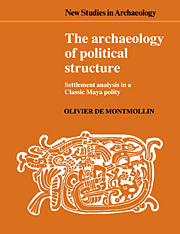Book contents
- Frontmatter
- Contents
- List of figures
- List of tables
- Preface
- 1 Studying ancient complex polities
- 2 Thinking about Maya political structure
- 3 The Rosario polity
- 4 Linking Maya politics and settlement
- 5 Centralization
- 6 Differentiation and integration
- 7 Political regimes and microcosms
- 8 Political stratification patterns
- 9 Mechanical versus organic solidarity
- 10 Segmenting versus non-segmenting organization
- 11 Archaeological study of Maya polities
- Notes
- References
- Index
8 - Political stratification patterns
Published online by Cambridge University Press: 29 March 2010
- Frontmatter
- Contents
- List of figures
- List of tables
- Preface
- 1 Studying ancient complex polities
- 2 Thinking about Maya political structure
- 3 The Rosario polity
- 4 Linking Maya politics and settlement
- 5 Centralization
- 6 Differentiation and integration
- 7 Political regimes and microcosms
- 8 Political stratification patterns
- 9 Mechanical versus organic solidarity
- 10 Segmenting versus non-segmenting organization
- 11 Archaeological study of Maya polities
- Notes
- References
- Index
Summary
Detecting political stratification
Political stratification concerns the unequal distribution of political rewards and inequalities in access to political offices. How to define presence or absence of political stratification is a secondary methodological question here, rather than a primary substantive focus as in cultural evolutionary studies of the origins of ranking or (economic) stratification (Service 1971; Carneiro 1981; Earle 1978). For the Rosario polity, I begin with the working assumption that it had clear political stratification: a regime featuring political inequalities, with privileged access to political offices for some. A basic division into rulers and ruled, leaders and subjects, or elite and commoner groups characterized most ancient Mesoamerican polities, at least from the Late Formative Period onward. There is no reason to believe that the Rosario polity was exceptional. Beyond sweeping generalizations, three specific lines of evidence locally sustain this assumption. First, the clear presence in the settlement record of a political settlement-hierarchy (an uneven distribution of civic-ceremonial facilities) means that the residents associated with differently ranked centers have differing access to political offices and activities. Second, considerable variability exists in domestic architecture attributes indicating hierarchical inequalities in sociopolitical status. In simplest terms, there was probably a set of sumptuary status-related rules about the appearance of dwellings. Third, differential distribution of special luxury items well meets the expectations for a stratified sociopolitical system. These items include polychrome pottery, fine imported pottery, figurines, jade-greenstone celts, seashell pendants, and so forth, all viewed as sumptuary sociopolitical status markers. Given a defensible assumption that there was political stratification (and not egalitarianism) in the Rosario polity, the problem then becomes one of investigating its nature.
- Type
- Chapter
- Information
- The Archaeology of Political StructureSettlement Analysis in a Classic Maya Polity, pp. 173 - 196Publisher: Cambridge University PressPrint publication year: 1989

